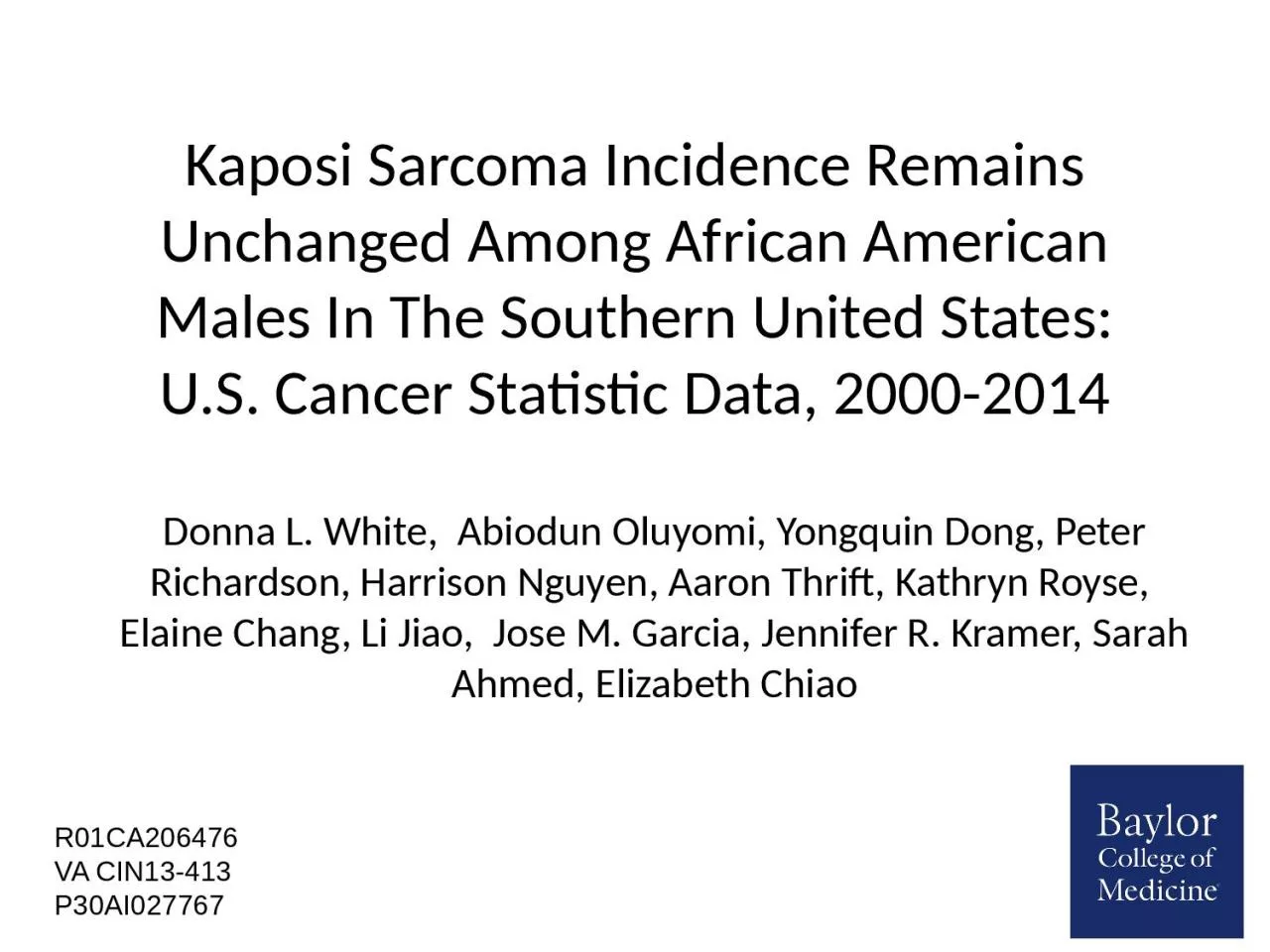

Donna L White Abiodun Oluyomi Yongquin Dong Peter Richardson Harrison Nguyen Aaron Thrift Kathryn Royse Elaine Chang Li Jiao Jose M Garcia Jennifer R Kramer Sarah Ahmed Elizabeth Chiao ID: 929413
Download Presentation The PPT/PDF document "Kaposi Sarcoma Incidence Remains Unchang..." is the property of its rightful owner. Permission is granted to download and print the materials on this web site for personal, non-commercial use only, and to display it on your personal computer provided you do not modify the materials and that you retain all copyright notices contained in the materials. By downloading content from our website, you accept the terms of this agreement.
Slide1
Kaposi Sarcoma Incidence Remains Unchanged Among African American Males In The Southern United States: U.S. Cancer Statistic Data, 2000-2014
Donna L. White, Abiodun Oluyomi, Yongquin Dong, Peter Richardson, Harrison Nguyen, Aaron Thrift, Kathryn Royse, Elaine Chang, Li Jiao, Jose M. Garcia, Jennifer R. Kramer, Sarah Ahmed, Elizabeth Chiao
R01CA206476VA CIN13-413 P30AI027767
Slide2Financial DisclosureDr. Chiao is an uncompensated advisor to Celgene
Dr. Kramer receives grants from Merck for Hepatitis C research
Slide3Introduction
Prior to effective antiretroviral therapy (ART) for HIV, KS risk was elevated by over 1,000-fold for people living with HIV (PLWH) compared to the general population Since the wide-spread availability of ART, the world-wide incidence of KS decreased but regional differences persist, percent decline is lower in Sub-Saharan Africa compared to other parts of the world In the United States, KS incidence rates in PLWH declined 83.5% between 1990-1995 and 1996-2002.
Dal Maso, Eur J Cancer 2001The AIDS-defining Cancer Project Working Group for
IeDEA
and COHERE in
EuroCoord
,
Clin
Inf
Dis, 2017
Engels EA,
Int
J Cancer 2008;
Slide4KS Epidemiology in the U.S.
National Cancer Institute’s (NCI’s) Surveillance, Epidemiology, and End Results (SEER)Higher incidence of KS was associated with areas of increased poverty (2005-2009)Among southern SEER sites, KS incidence increased among African American men (2000-2013)registry-confirmed cancer cases (CA, CT, GA, HI, IA, KY, LA, NJ, NM, and UT) as well as data on select population (AL: Alaska Natives; AZ: Native American Indian; MI: Detroit; and WA: Seattle/Puget Sound)
Boscoe, Cancer, 2014Royse, PLOSone, 2017
Slide5Objective and Methods
Primary Objective: To identify differences by age, race, and geographic differences in KS incidence trends using the United States Cancer Statistics (USCS) registry Methods: USCS registry were assessed via the CDC’s Wide-ranging Online Data for Epidemiologic Research platform (WONDER , accessed 12/2017)All incident KS cases are coded within this registry using the International Classification of Disease for Oncology (ICD-O) as 9140/03Limited to males aged 20-54 as compose most AIDS-related KS
Slide6Methods
Chloropleth (heat map) of average age-adjusted rates of incident AIDS-related KS in all 50 states for four consecutive three-year time periods starting in 2003KS: WONDER, AIDS: CDC NCHHSTP Registry, Trends in annual KS incidence rates employing the National Cancer Institute’s
Joinpoint program Annual Percentage Change (APC) in incidence rates and Average Annual Percentage Change (AAPC) Monte Carlo permutation–based methods to assess statistical significance of linear trends, with two-sided p-values <0.05 considered statistically significant.
Dal
Maso
L. Br J Cancer, 2005
Royse,
PLOSone
, 2017
Slide7Maps of AIDS and KS Age-Adjusted Incidence Rates by Year per 100,000 population
Slide8Age-Adjusted KS Incidence Rates per 100,000 by Geographic Region
Slide9Age-Adjusted KS Incidence Rates per 100,000 by Metropolitan Area (Top 5 total cases)
Slide10KS Incidence Rates per 100,000 in the U.S. by Age
Slide11Age-Adjusted KS incidence Rates per 100,000 in the U.S. by Race/Ethnicity
Slide12KS Incidence per 100,000 among African American Men by Age
Slide13Age-adjusted KS incidence Rates per 100,000 in African American Men by Geographic Region
Northeast - 3
Joinpoints
──
─
2000 - 2002 APC
=
4.29
──
─
2002 - 2009 APC = -8.53*
───
2009 - 2012 APC = -0.23
───
2012 - 2014 APC = -26.17*
Midwest - 0
Joinpoint
───
2000 - 2014 APC = -3.40*
South - 0
Joinpoint
───
2000 - 2014 APC = -0.86
West - 0
Joinpoint
───
2000 - 2014 APC = -5.59*
Slide14Summary
Between 2000-2014, APC of KS significantly increased among men age 20-29, decreased in those 30-44, and was unchanged among men aged 45-54 Among African American Men, APC significantly increased in the 20-29 age-group, and there was no significant change in APC in AA men overall in the Southern United States Among the top 5 MSAs, KS incidence APC non-significantly increased in Atlanta, Georgia, and in 2014, its KS incidence was nearly twice that of NY, NY
Slide15Future DirectionsFuture KSHV epidemiology and KS treatment and prevention in the U.S. should focus on closing the persistent gaps in regional, racial and age disparities identified in KS incidence
Slide16Acknowledgements
Co-Authors:Donna L. White Abiodun Oluyomi
Yongquin Dong
Peter Richardson
Harrison Nguyen
Aaron Thrift
Kathryn Royse
Elaine Chang
Li Jiao
Jose M. Garcia
Jennifer R. Kramer
Sarah Ahmed
Project Staff:
Roxanne
Desiderio
Suchismita
Raychaudbury
Dina Sanchez